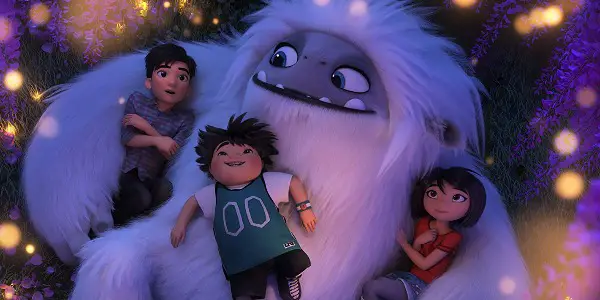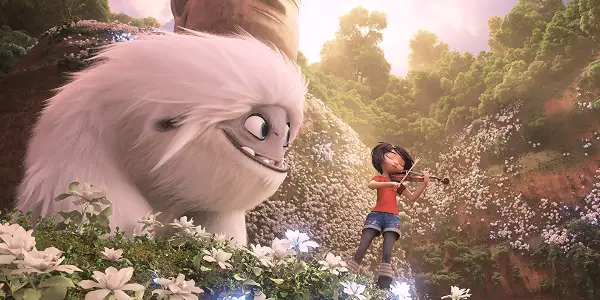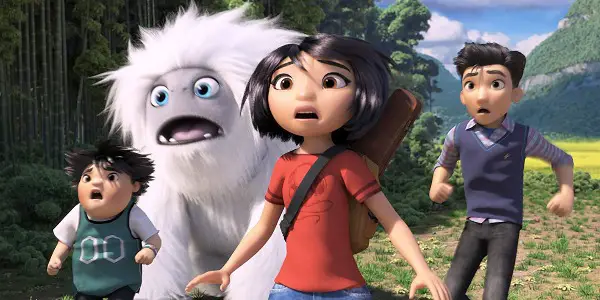ABOMINABLE: Family Adventure Delivers Impressive Animated Spectacle

I'm a student at the University of North Carolina at…
It seems potentially ill-advised to apply some kind of auteurist template to an animation studio, but if we can rank and discuss Pixar movies as if they were all made by the same group of creatives, why not do the same for Dreamworks Animation? I bring this up only because the studio’s two 2019 films, March’s How to Train Your Dragon: The Hidden World and the recent Abominable, both seem to be driven by the same basic artistic impulses and inclinations. Where previous Dreamworks titles like The Boss Baby and the Shrek franchise treasured satire and absurdity over gracefulness, 2019’s Dreamworks offerings prioritize spectacle and heart over the elements that defined their previous films.
It is worth noting that Abominable is Dreamworks’ first collaboration with Pearl Studio, a Chinese production company that will likely be a major player on the animation scene for years to come. And it’s also necessary to consider that Dreamworks’ upcoming lineup includes sequels to Trolls, The Croods, and The Boss Baby: it’s distinctly possible that the gentle feel of the studio’s 2019 output may be short-lived. Yet despite the unavoidable fact that Abominable still has many of the requisite jokes and chase scenes required by contemporary kids movies, it’s a beautiful and enjoyable experience, armed with just enough whimsy and eye-popping color to stand out in an increasingly monotonous climate.
A Journey to the Himalayas
Written and directed by Jill Culton, Abominable begins in Shanghai, where a young Yeti named Everest (voiced by Joseph Izzo, though the character does not talk, unlike the Yetis in last year’s Smallfoot and this April’s Missing Link) has escaped from the scientists and capitalists who have held him hostage. On the run from Dr. Zara (Sarah Paulson), a devoted scientist with a pet mouse, and Burnish (Eddie Izzard), an industrial tycoon who has pursued the mystical Yeti for most of his life, Everest avoids his captors in a rooftop hideaway. The helicopters fly away, and it seems like Everest is all alone and safe on this Shanghai hideout.

But this city rooftop is also the favorite hiding spot of Yi (Chloe Bennet), a teenage girl suffering from a tremendous, heartbreaking loss. Her father died recently, and instead of processing her grief by spending time with her mother (Michelle Wong) and grandmother (Tsai Chin), Yi spends her days running around Shanghai, doing odd jobs and earning a little bit of cash each day. Her hope is to travel throughout the country, seeing the beautiful sights and visiting the tourist destinations that her father held dear. At night, Yi climbs onto the roof of her apartment building to play the violin– something her family thought she gave up long ago.
Of course, this is where the paths of Yi and Everest cross for the first time. At first, she’s scared of the giant creature, until she realizes that he’s just scared, hungry, injured, and all alone. Eventually, Yi comes to understand that Everest desperately wants to go home to his family in the Himalayan mountains, and along with young Peng (Albert Tsai) and narcissistic, but kind-hearted Jin (Tenzing Norgay Trainor), the group sets out on an epic journey. But with Burnish Industries and Dr. Zara chasing after them the whole time, it won’t be easy for these four friends to complete their quest.
Spectacle over Story — And Not in a Bad Way
Despite resistance from the buffoonish guards of this industrial icon, Yi and company have one special weapon: Everest’s magical powers. These powers don’t necessarily receive an explanation of any kind (it’s something to do with his hair), but when Everest and his friends are in a jam, he can basically accomplish anything. This is absolutely a narrative shortcut to move Yi and Everest to their next location swiftly and smoothly, but when a story choice inspires such gorgeous, colorful animation, does it really matter if it’s the easy way out?

I saw Abominable in Dolby Cinema, which probably improved the crispness and richness of the projection quality in a substantial way, but that doesn’t account for the imaginative visual stamp on display. The animation here isn’t even particularly realistic– it certainly doesn’t resemble Pixar’s recent hyper-realistic renderings of physical, tactile settings– but it’s always amazing to witness, as the film plays like a collection of set-pieces driven by spectacular flights of beautiful fantasy. So even though the hectic pace demanded by contemporary kids movies is still present, Abominable pauses for scenes of sheer wonder and awe; in these moments, it’s more like Spirited Away than your typical Dreamworks outing. I wish more family films followed suit.
Amusing/Troubling Political Subtext in Cute Fable
Beyond the soothing spectacle of the animation, I have to admit that there’s nothing truly groundbreaking or novel to be found, though that’s not necessarily a bad thing. We’ve all seen Abominable‘s story played out dozens of times: so many young adults in crisis have found comfort in the presence of a cuddly, mystical new friend. In fact, I caught up with Travis Knight‘s Bumblebee a few days later and felt a striking sense of deja vu– hadn’t I just recently watched the story of a girl, who recently lost her father, going through the process of grief with the help of a magical creature? Regardless, this story works for a reason, and Abominable stretches its solid premise in poignant, often effective ways, even reaching an emotionally satisfying, bittersweet conclusion.

There is, however, one simultaneously troubling and amusing bit of political subtext that I haven’t seen mentioned in many Film Twitter circles (not that many critics are debating the politics of a Dreamworks movie when Joker is sucking up all the oxygen). The film is initially positioned as a tale of the capitalistic exploitation of science and nature, as Burnish’s whole goal is get Everest back in his custody. Eventually, the story pulls a bit of a switcheroo, turning an anti-corporate narrative into a familiar mad scientist routine, even going so far as to provide a redemptive arc for the cartoonish capitalistic icon. It’s certainly an unexpected twist, but it feels like noticeably forced at times, and the unabashed evil of the film’s eventual antagonist feels ill-advised. Then again, this is such a small and minuscule development with possibly unintentional political implications, so it’s not even close to being a disqualifying or limiting factor.
Abominable: Conclusion
More than a decade after Open Season (a movie I actually remember watching as a kid), writer/director Culton returns with a strong sophomore outing, filled with enough grandeur and heart to keep viewers engaged. Abominable isn’t a transcendent animated journey, but it effectively hits a series of sweet notes, chugging right along and coasting off the beauty of its designs and the sheer cuteness of its main fantastical creation.
Plus, if Abominable (along with the recent How to Train Your Dragon sequel) is any indication that Dreamworks is eager to reinvent their brand with this type of visually sumptuous adventure as the template, bright things could be ahead for this powerhouse studio.
What did you think of Abominable? Would you like to see more Dreamworks collaborations with Pearl Studio? Let us know in the comments below!
Watch Abominable
Does content like this matter to you?
Become a Member and support film journalism. Unlock access to all of Film Inquiry`s great articles. Join a community of like-minded readers who are passionate about cinema - get access to our private members Network, give back to independent filmmakers, and more.
I'm a student at the University of North Carolina at Chapel Hill. For 8 years, I've edited the blog Martin on Movies. This is where I review new releases, cover new trailers, and discuss important news in the entertainment industry. Some of my favorite movies- Casablanca, Inception, Singin' in the Rain, 2001: A Space Odyssey, The Wolf of Wall Street, The Nice Guys, La La Land, Airplane!, Skyfall, Raiders of the Lost Ark. You can find my other reviews and articles at Martin on Movies (http://martinonmovies.blogspot.com/).













